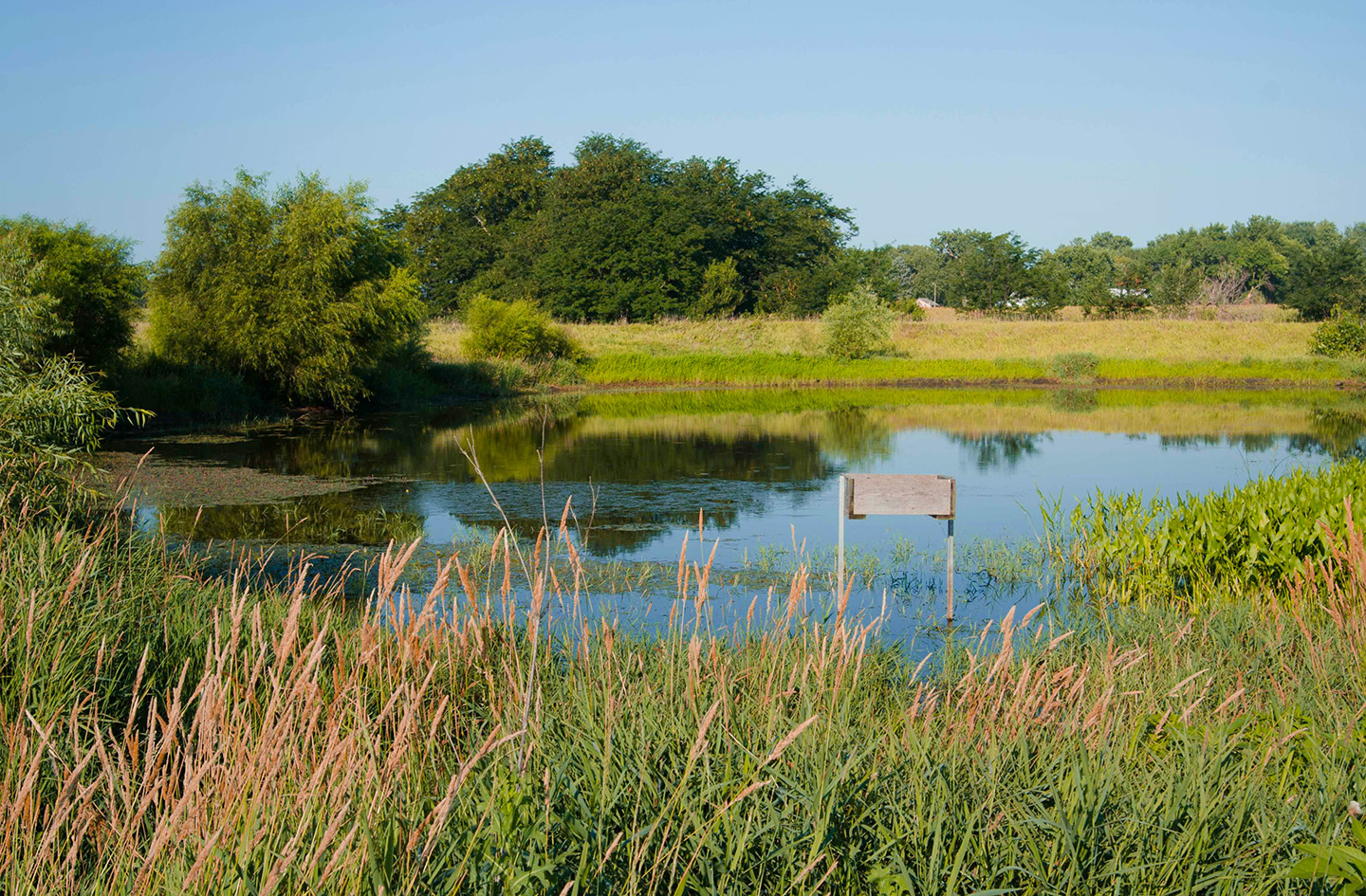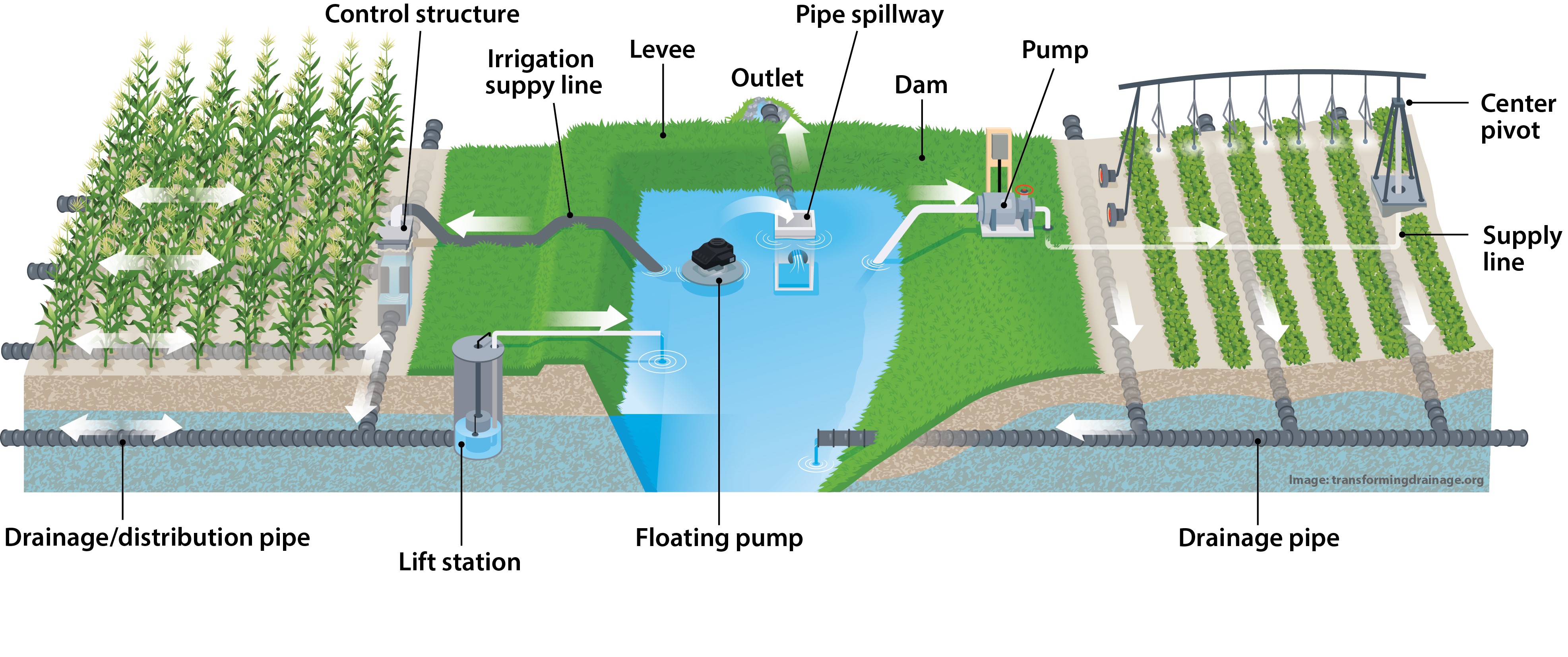
The reservoir within a drainage water recycling site holds excess drainage tile water to be used for irrigation during the growing season. Drainage water recycling was the subject of the most recent Innovation To Go Webinar.(Photo: Iowa Soybean Association).
What drainage water recycling can do for the fields and the streams
August 4, 2022 | Kriss Nelson
Could a system help manage the influx of water we receive in the spring and store it for later use during the dry episodes in the summer?
Chris Hay, Iowa Soybean Association (ISA) senior research scientist, answered that question during Tuesday’s Innovation To Go Webinar covering drainage water recycling.
“That is where the idea of drainage water recycling comes in,” says Hay. “We can keep the water when we have too much of it in the spring and store it in a reservoir for supplemental irrigation in the summer when we have too little water.”
Hay says drainage water recycling is an “intensified form of water management.”
Drainage recycling water systems
Drainage recycling water systems can be engineered to fit a particular field’s characteristics, Hay says.

The above graphic shows using subirrigation on the left. Hay says this is where water is being pumped back through the same tile lines used for drainage. The water will be brought back by raising the water table to the bottom of the root zone.
The righthand side of the graphic shows a traditional irrigation system utilizing a center pivot. This system could also use a subsurface drip or, in the right conditions, might be an opportunity for surface irrigation.
The reservoir will collect the water. In some cases, Hay says this can be within a waterway with an embankment dam or excavating the storage to build up a levee to create a reservoir might be an option.
Drainage water recycling research results
ISA and Iowa State University participated in Transforming Drainage – a multi-state study conducted throughout eight states to develop ways to re-envision how drainage is implemented across the agricultural landscape.
Through the study, Hay and others discovered that 64% of the site years researched at the drainage water recycling sites, saw a corn yield increase with an average increase of 19 bushels per acre.
In addition to increased yield, results showed a reduction in yield variability.
“The range of yields was less with drainage water recycling,” says Hay. “Not only did we get higher yields, but there was more consistent crop production by recycling drainage water as opposed to just free drainage.”
Studies also provided insight into the optimal time to irrigate.
“Building storage for drainage water recycling is going to be expensive, and you want to optimize how you use that supplemental irrigation,” says Hay.
For corn, research revealed that irrigating in the late vegetative stages from V9 to the early reproductive stages of R1 and R2 was the most critical time to utilize supplemental irrigation.
To bring research for drainage water recycling research to Iowa, Hay has been working with farmers and Matt Helmers, director of the Iowa Nutrient Research Center and a professor in the Department of Agricultural and Biosystems Engineering at Iowa State University (ISU), to collect and interpret data from trials on a farm near Story City.
The system was installed in 2015. In most of the years, the farm has benefited from supplemental irrigation from water stored through their drainage water recycling system.
“Overall, from 2016 through last year, there was an average increase of 36 bushels an acre compared to rainfed conditions as far as corn yield,” says Hay.
Additional drainage water recycling benefits
Water quality is also affected by a drainage water recycling system. Modeling results show a 24-27% reduction in nitrogen loads and a 21-39% reduction in phosphorus loads keeping those nutrients out of downstream water, Hay says.
Potentially, drainage water recycling could become a part of a larger drainage infrastructure, for example, a drainage district where storage could help with drainage system capacity.
“By having that water storage, if we do enough of these where we have reservoirs out in the landscape, we have that potential to store and buffer water that could potentially reduce downstream flood impacts,” says Hay.
Drainage water recycling needs
Although drainage water recycling is showing potential, there is still research needed to advance the practice.
“We need more monitored field sites,” he says. “We have a fairly limited number of sites, and the more different situations we have to compare, the better picture we will get as to how this performs.”
Two new sites have been developed thanks to the partnership with ISU and grant assistance from the Iowa Department of Agriculture and Land Stewardship (IDALS). One site is now running in Calhoun County, and another is near completion in Webster County.
Funding
Through the Natural Resources Conservation Service (NRCS) Environmental Quality Incentives Program (EQIP), drainage water recycling systems are now an approved practice on the federal level that could help to finance new sites if adopted by the state.
At the state level, Hay says IDALS is interested in the practice and has helped fund site construction. Currently, the funding is not available to offset irrigation system costs, but it can help fund storage and other components that go into the system.
Innovation to Go Webinar series
The Innovation to Go Webinar series wraps up its summer season of programming with the final presentation from 12-1 p.m. Tuesday, Sept. 13.
Keys to Improved Soil Health, Water Quality and Profitability, will be presented by Heath Ellison, senior field services program manager; ISA conservation agronomists Ryan Johnson, Ben Porepp, Rosie Roberts and Joe Wuebker.
ISA Research Center for Farming Innovation conservation agronomists will discuss their role in assisting farmers and landowners with adopting conservation practices. An interactive panel discussion will highlight the value of in-field and edge-of-field practices in improving soil health and water quality and increasing farmer profitability.
Register here for the webinar.
Back